Reynoutria X Bohemica Chrtek & Chrtková and
Reynoutria X Bohemica Chrtek & Chrtková and
Reynoutria X Bohemica Chrtek & Chrtková and
You also want an ePaper? Increase the reach of your titles
YUMPU automatically turns print PDFs into web optimized ePapers that Google loves.
TWO ALIEN SPECIES IN THE SPREADING PROCESS IN ROMANIA<br />
riparian, xerophytic <strong>and</strong> shrubby communities, pastures, ab<strong>and</strong>oned arable l<strong>and</strong>s,<br />
<strong>and</strong> severely degraded habitats, along roadsides <strong>and</strong> railways, as well as in the<br />
river basins (Protopopova & Shevera, 1999; Protopopova et al., 2006; Mîrza et<br />
al., 1987; Negru (ed) 2006), or even in natural reservations (Ursu (ed) 2005).<br />
It is also considered as potentially invasive in Spain (Sanz Elorza et al.,<br />
2001).<br />
In Romania, this species has been recently identified in the ruderal places<br />
of the siding lines from the Socola-Iaşi railway station (Sîrbu & Oprea, 1998;<br />
Ciocârlan, 2000; Sîrbu, 2004; Oprea, 2005). Meantime, the population from the<br />
Socola-Iaşi station has been notable extended, conquering an area of thous<strong>and</strong><br />
square meters <strong>and</strong> becoming an important constituent of the anthropic vegetation<br />
from those ruderal places.<br />
Recently, in September 2006, we have also found this species in the South<br />
of Moldavia (Romania), at Galaţi, where it vegetates under prosperous conditions,<br />
on some tens of hectares, along railway embankment, as well as on ruderal places<br />
around railway, along Portului Street, <strong>and</strong> the surroundings of Galaţi-Larga<br />
station. We suppose that in this location, as well as in Socola-Iaşi, this plant<br />
arrived from the Republic of Moldova, with goods or passenger trains.<br />
At present, Grindelia squarrosa can be thus considered fully naturalized in<br />
Romania, having an evident invasive character.<br />
CONCLUSIONS<br />
This paper is a contribution to the knowledge of the distribution of two<br />
alien species (<strong>Reynoutria</strong> x bohemica, <strong>and</strong> Grindelia squarrosa), both recently<br />
detected in the flora of Romania.<br />
<strong>Reynoutria</strong> x bohemica, known in Europe as a very important invasive<br />
species, is cited now for the first time in Moldavia (between the Eastern<br />
Carpathians <strong>and</strong> the Prut River). <strong>Reynoutria</strong> x bohemica presents a strong<br />
invasive character, forming well-developed phytocoenoses, which replace the<br />
native vegetal communities on large areas, especially along watercourses, in<br />
Transylvania <strong>and</strong> in Moldavia.<br />
Grindelia squarrosa, previously reported in 1998, at the Socola-Iaşi<br />
railway station (for the first time in the flora of Romania), was also found, in<br />
2006, at Galaţi, in the Southern Moldavia (Eastern Romania), where it presents an<br />
evident invasive character in the anthropic habitats.<br />
REFERENCES<br />
Balogh L., 2003 - A Fallopia nemzetség <strong>Reynoutria</strong> szekciója Magyarországon elöforduló<br />
fajainak határozókulcsa. Flora Pannonica 1(1): 76-88<br />
Balogh L., Bailey J., 2003 - Species of the genus Fallopia sectio <strong>Reynoutria</strong> in Hungary -<br />
a l<strong>and</strong> of the hybrid Fallopia x bohemica ? Abstracts of the 7 th International<br />
47



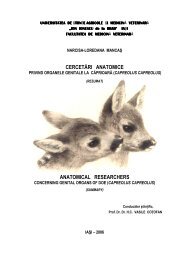
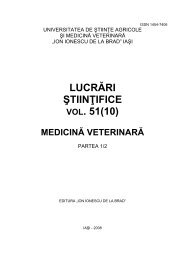
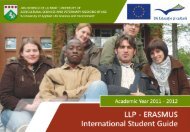
![rezumat teză [RO]](https://img.yumpu.com/19764796/1/190x245/rezumat-teza-ro.jpg?quality=85)
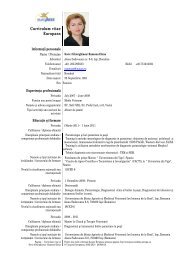



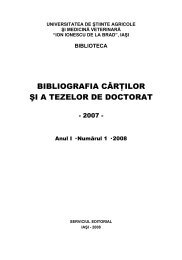
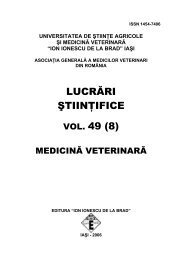
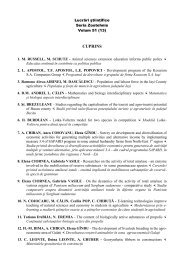
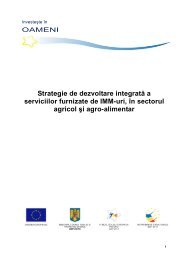
![rezumat teză [RO] - Ion Ionescu de la Brad](https://img.yumpu.com/14613555/1/184x260/rezumat-teza-ro-ion-ionescu-de-la-brad.jpg?quality=85)
